ISSN: 2320-0189
ISSN: 2320-0189
Valentina Klymiuk1, Sophia Barinova2*, and Natalya Lyalyuk1
1Department of Botany and Ecology, Donetsk National University, 46 Schorsa St., Donetsk 83050, Ukraine
2Institute of Evolution, University of Haifa, Mount Carmel, 199 Abba Khoushi Ave., Haifa 3498838, Israel
Received date: 13 January 2014 Accepted date: 20 February 2014
Visit for more related articles at Research & Reviews: Journal of Botanical Sciences
We revealed 238 species and infraspecific taxa of algae and cyanobacteria in phytoplankton communities in lakes of the Regional Landscape Park “Slavyansky Resort”, Ukraine during 2007-2013 of the total 352 known in the region assigned to nine taxonomic Divisions with Bacillariophyta, Cyanoprocaryota, and Chlorophyta prevailing. The bio-indication methods applied for the first time characterizes the aquatic environments as slightly alkaline, medium-enriched with oxygen, temperate, clear to moderately polluted, of Water Quality Classes II-III, eutrophic, but with photosynthetic algal nutrition attesting to insignificant concentration of toxic substances despite a considerable anthropogenic impact. The algal diversity is depressed with salinity of the lakes. The statistical analysis defines two clusters, the northern with perennial lakes Ripne, Veysove, Garache, and Slipne, and southern of partially drained lakes Levadne, Chervone, and Lake. Aridity is a major factor of water chemistry inflicting high salinity and depletion of species diversity. Historically salinity might have played a leading role in shaping the algal communities of the region.
Phytoplankton, Diversity, Ecology, Salinity, Slavyansky Resort, Ukraine
The algal diversity research in the Regional Landscape Park “Slavyansky Resort” dates from the second half of XVII century but the flora is poorly studied so far relative to general level of algological research in the country [1,2]. In 2007 we started an extensive monitoring in order to assess climatic and anthropogenic impacts on the lakes phytoplankton species diversity and ecological characteristics [3].
Initially we worked out a species inventory that is here used as a basis for inter-lake floristic comparisons, bio-indication of environmental variables and analysis of the diversity trends in response to climatic influence and the levels of anthropogenic pollution, using the statistical approaches linking structural and functional aspects of lacustrine communities [4].
State of knowledge
Studies of the species composition of algae were conducted sporadically since the second half of the 17th century by many scientists [1,2,5]. Since the mid-20th century, researchers have turned their attention to identifying the role of microorganisms involved in the formation of therapeutic mud lakes and in the circulation of substances in lakes in general [1,2,5]. Modern systematic lists of planktonic algae are presented by NM Lyalyuk and VN Klimyuk [3].
Description of study site
`Regional landscape park "Slavyansky Resort" was created in 2006. The purpose of its creation was for the preservation and thoughtful use of unique natural complexes and artificial plantations of parkland, and the development of recreation. The park is located in the northeastern part of the city Slaviansk in Ukraine. Its area is 431 hectares and includes three resorts, extensive park, a seasonal ornithological reserve "Priozernyy", and natural “monuments” of national importance, lakes Ripne and Slipne, which are sources of unique therapeutic mud and brine (Given the Belgium Grand Prix award in 1907) [6] (Figure 1).
Just inside the park are seven perennial lakes (Ripne, Veysove, Garache, Slipne, Levadne, Chervone, and untitled lake (hereinafter – Lake) and many temporary pools. The studied lakes are mostly of thermokarst origin, small, and shallow. These lakes are insulated from each other and periodically dry up. They are briefly interconnected in spring. Sediments of the lakes are diverse varying from sand to medical mud. Water is slightly yellow or colorless with pH 6.3–8.0, and conductivity is 1.31–11.26 mSm/cm. Depth of the lakes is negligible (about 0.5–2.5 m) and only in lake Ripne does it reach 8.5 m. They form a unique community of organisms, including algae, which are the basis for the formation of therapeutic mud. In lake Ripne there is industrial fishing for mud and brine mud baths for the Slavyansky Resort – one of the oldest mud-bath resorts of Ukraine.
The water bodies are subjected to an intense recreational load, since most of the banks are designated for swimming and relaxing. Aquatic macrophyte vegetation is abundant, serving as part of the staple diet and habitat of protected species of birds.
The park has an area of 134 hectares. There are more than 110 species of trees and shrubs. The flora of the park is represented by three species of medicinal plants, which are listed in the Red Book of Ukraine. Lakeshores serve as nesting locations for a large number of birds, including species of the Red
Book of Ukraine: Himantopus himantopus Linnaeus and Tadorna ferruginea Pallas. Also, there are 11 bird species in the local avifauna, which were placed on the list of rare and endangered species in Europe.
Material for this work comes from samples collected monthly during 2007-2013 in lakes Ripne, Veysove, Garache, Slipne, Levadne, Chervone, and Lake. Phytoplankton samples were collected in the littoral and profundal zones of the lakes. A sample volume was 2 L and concentrated by an accumulation on membrane filters "Vladipor» No 7, or a 10–20 L sample, concentrated using a plankton net number 77. Algae studied in live and fixed (4% formaldehyde solution) states, using light microscopes MBI-3 and Micros MC 50 (Austria) with magnification of 40X–90X (with immersion). Permanent slides were made for the study of diatoms [7]. Determination of algal species was performed using international series determinants of marine and freshwater algae. A systematic list based on a system adopted in «Algae of Ukraine» [1, 2] and «Cyanoprokaryota» [8]. Species not found in «Algae of Ukraine» were added according to the classification adopted in the database at www.algaebase.org.
The ecological characteristics of algal species were obtained from the database compiled for freshwater algae of the world from multiple analyses of algal biodiversity by S.S. Barinova et al. [9], with additions of C. Ter Braak [10] and H. van Dam [11], according to substrate preference, temperature, oxygenation, pH, salinity, organic enrichments, N-uptake metabolism, and trophic states. The ecological groups were separately assessed according to their significance for bio-indications. Species that respond predictably to environmental conditions were used as bio-indicators for particular variables of aquatic ecosystems, the dynamics of which are related to environmental changes. The statistical methods are those recommended by V. Heywood [4] for the development of floristic and taxonomic studies. Polynomial trend lines are functions that describe general trends. A standard deviation line cut off the groups with the majority of indicator species. The GRAPHS program [12] was used in comparative floristic approaches for calculating similarity of algal communities in the studied lakes.
We studied 121 phytoplankton samples from seven lakes of the Regional landscape park "Slavyansky Resort" collected in May-November 2007, March-November 2008, and April 2012 – June 2013.
Altogether 334 species of algae (352 species and infraspecific taxa) from nine taxonomic Divisions (Cyanoprocaryota, Euglenophyta, Chrysophyta, Dinophyta, Xanthophyta, Cryptophyta, Bacillariophyta, Chlorophyta, and Charophyta), 38 Orders, 71 Families, and 137 Genera (Table 1) have been revealed including the original data (238 species and infraspecies), the data from the workbooks of the Slavyansk hydro-geological regime-operational station (134 species and infraspecies), and data from references (47 species and infraspecies, of which 40 species and infraspecies were only found in the recent references [1, 2]).
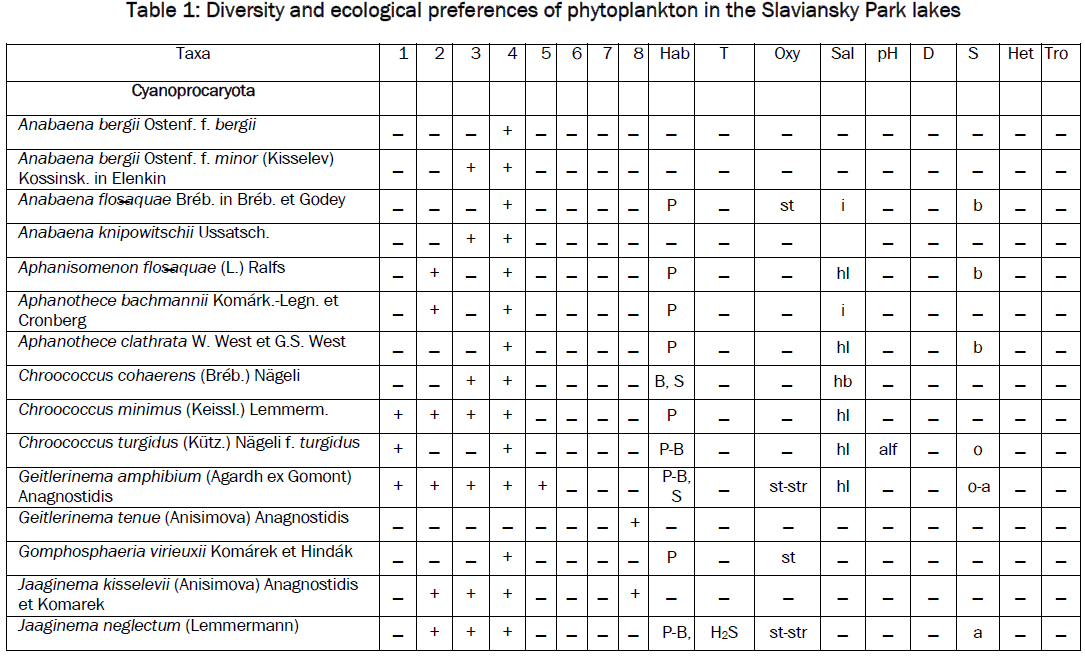
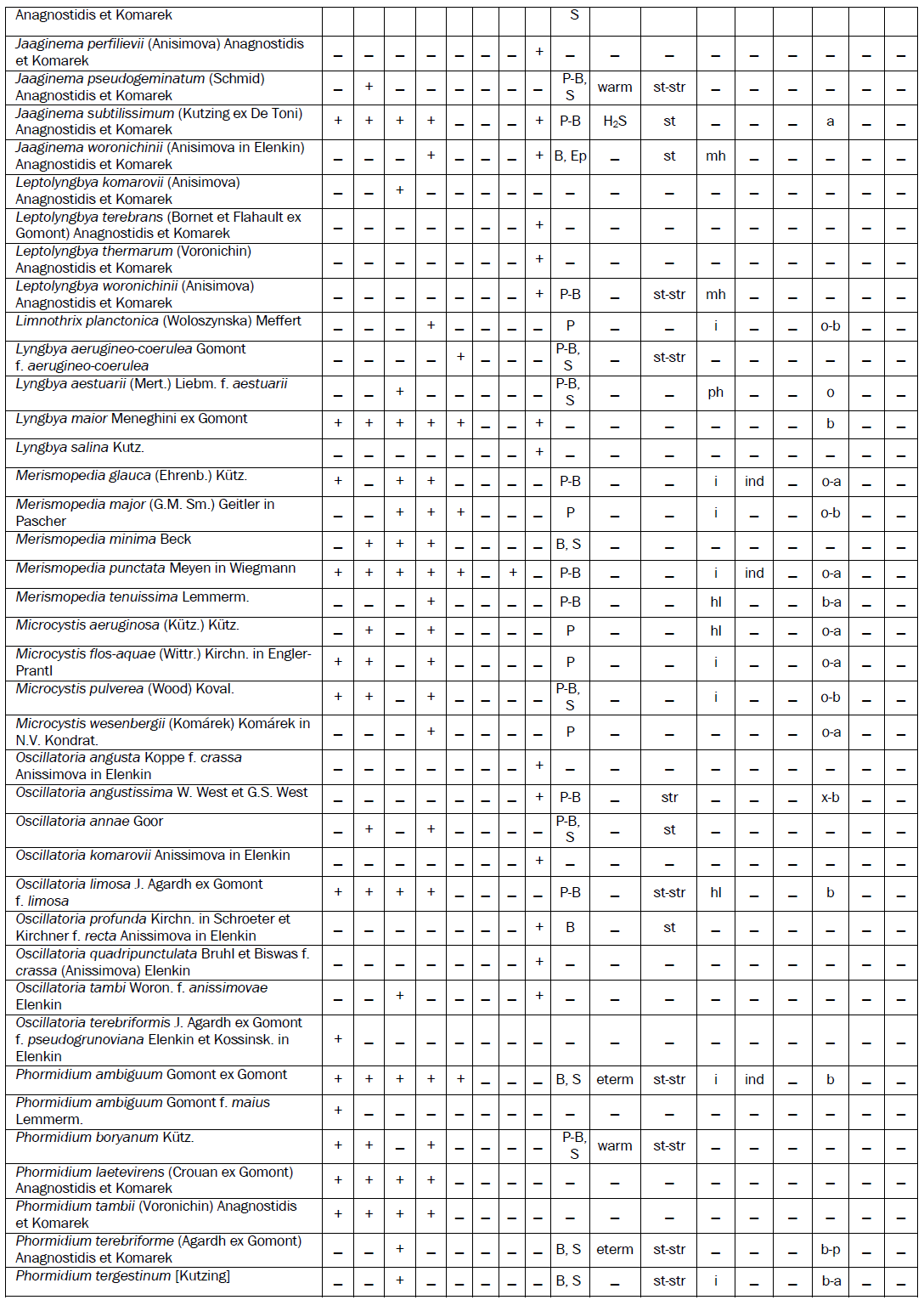
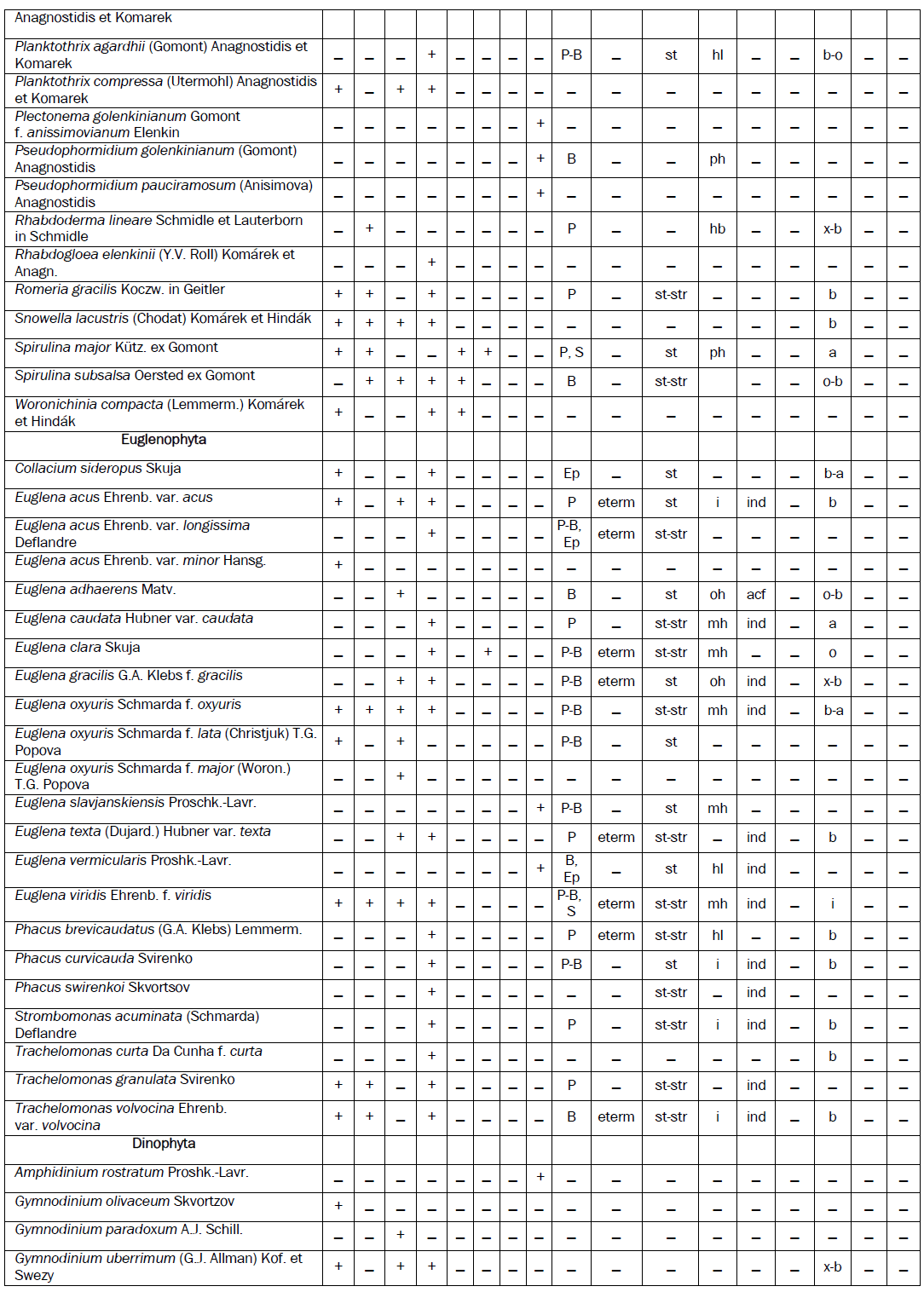
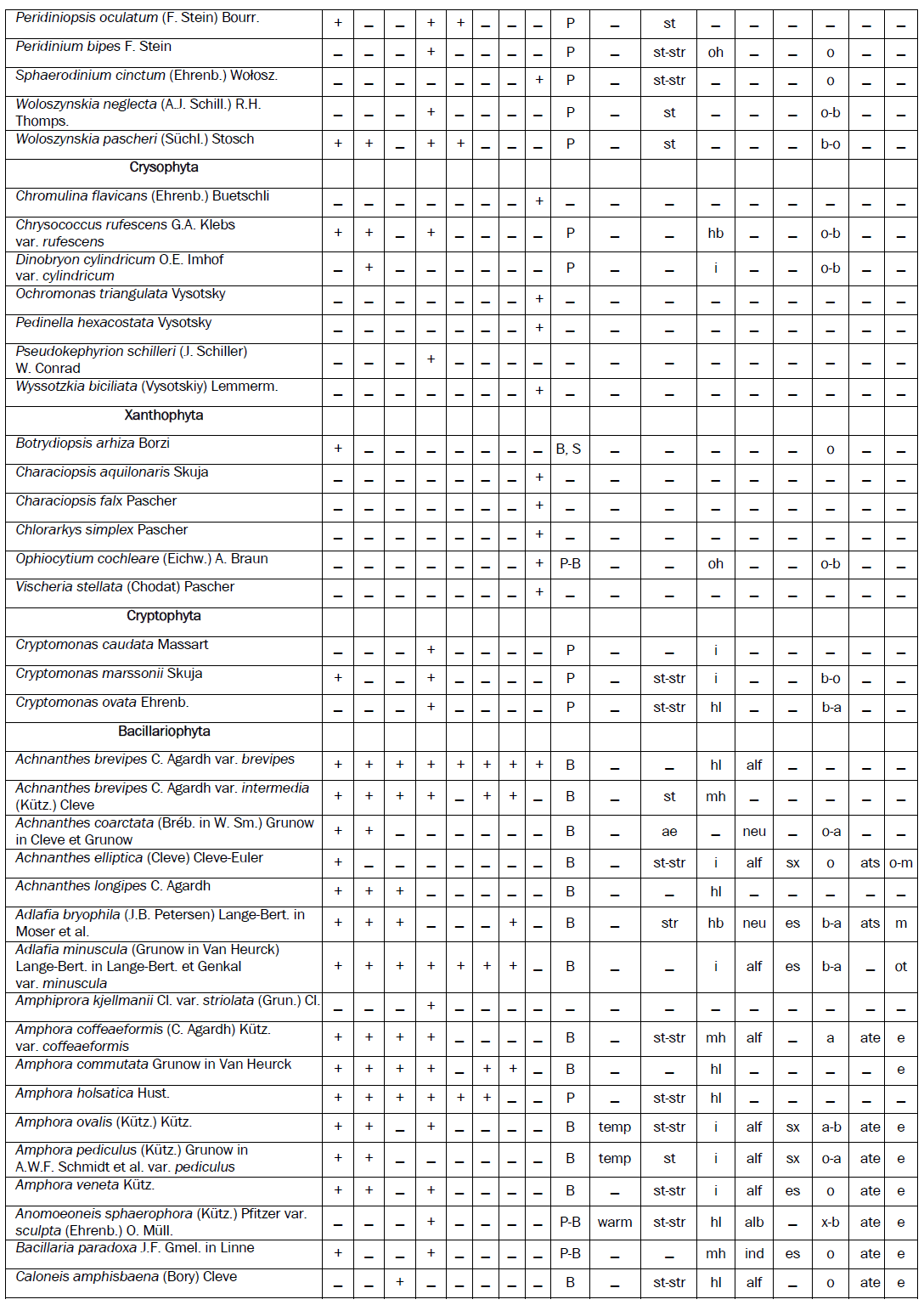
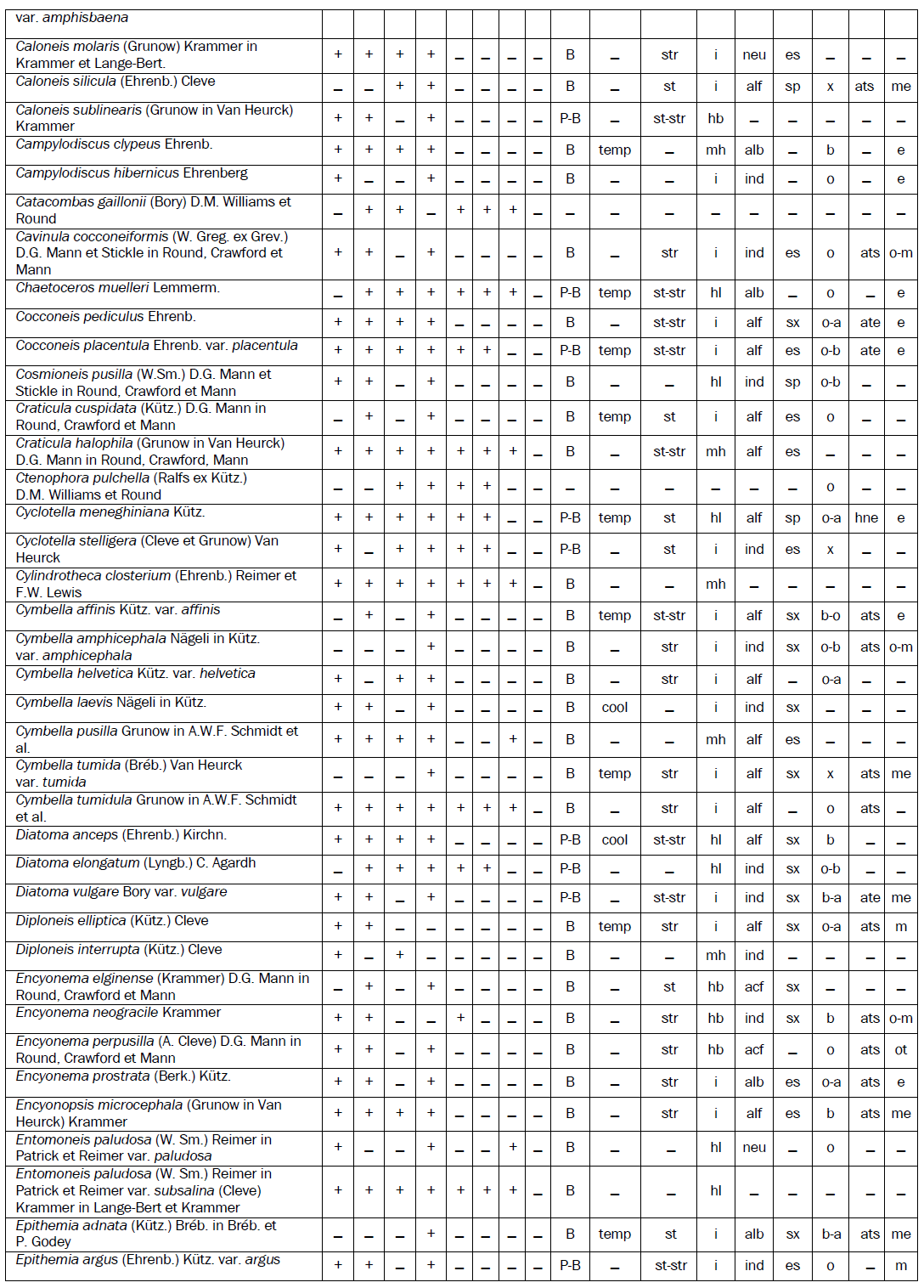
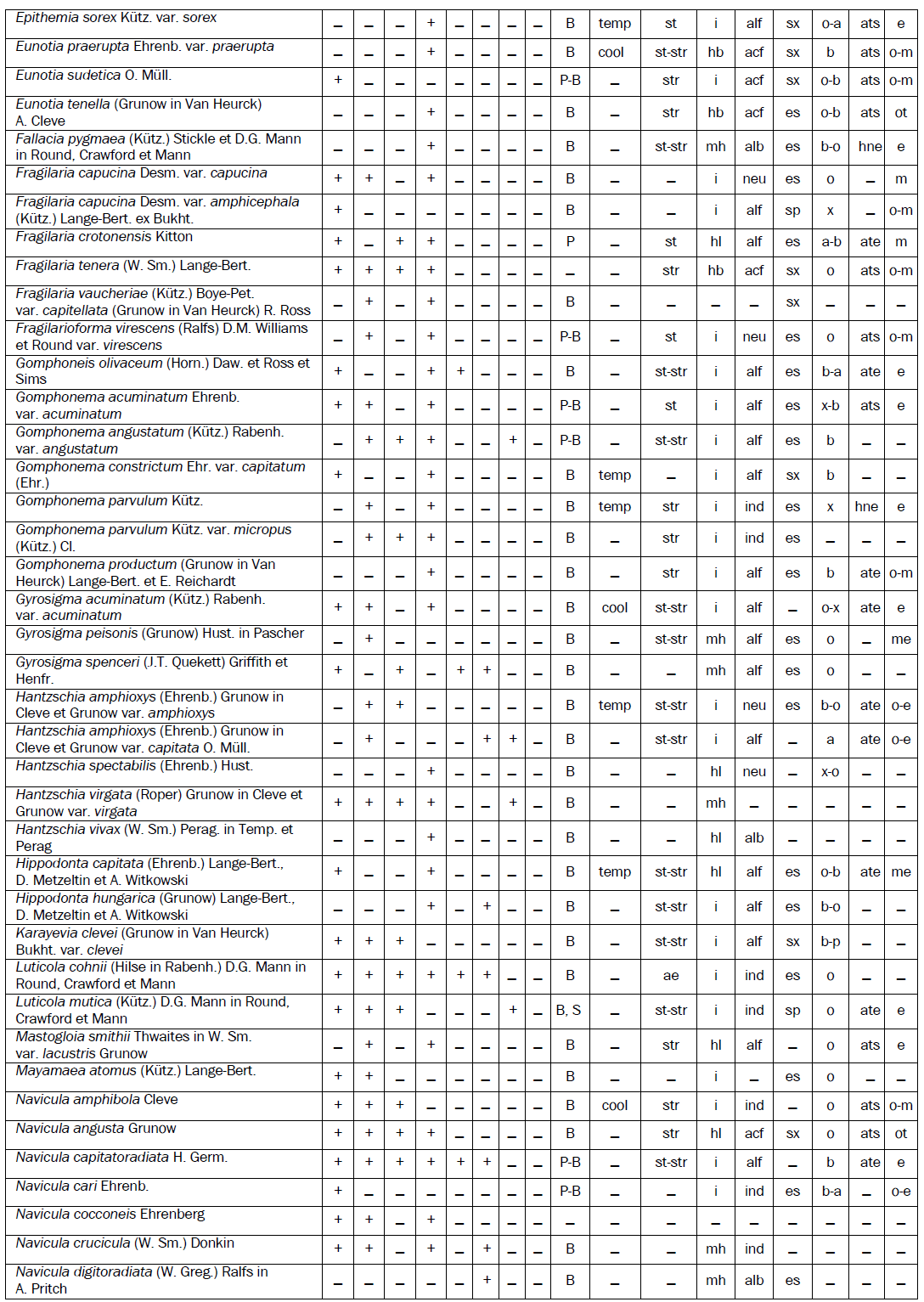
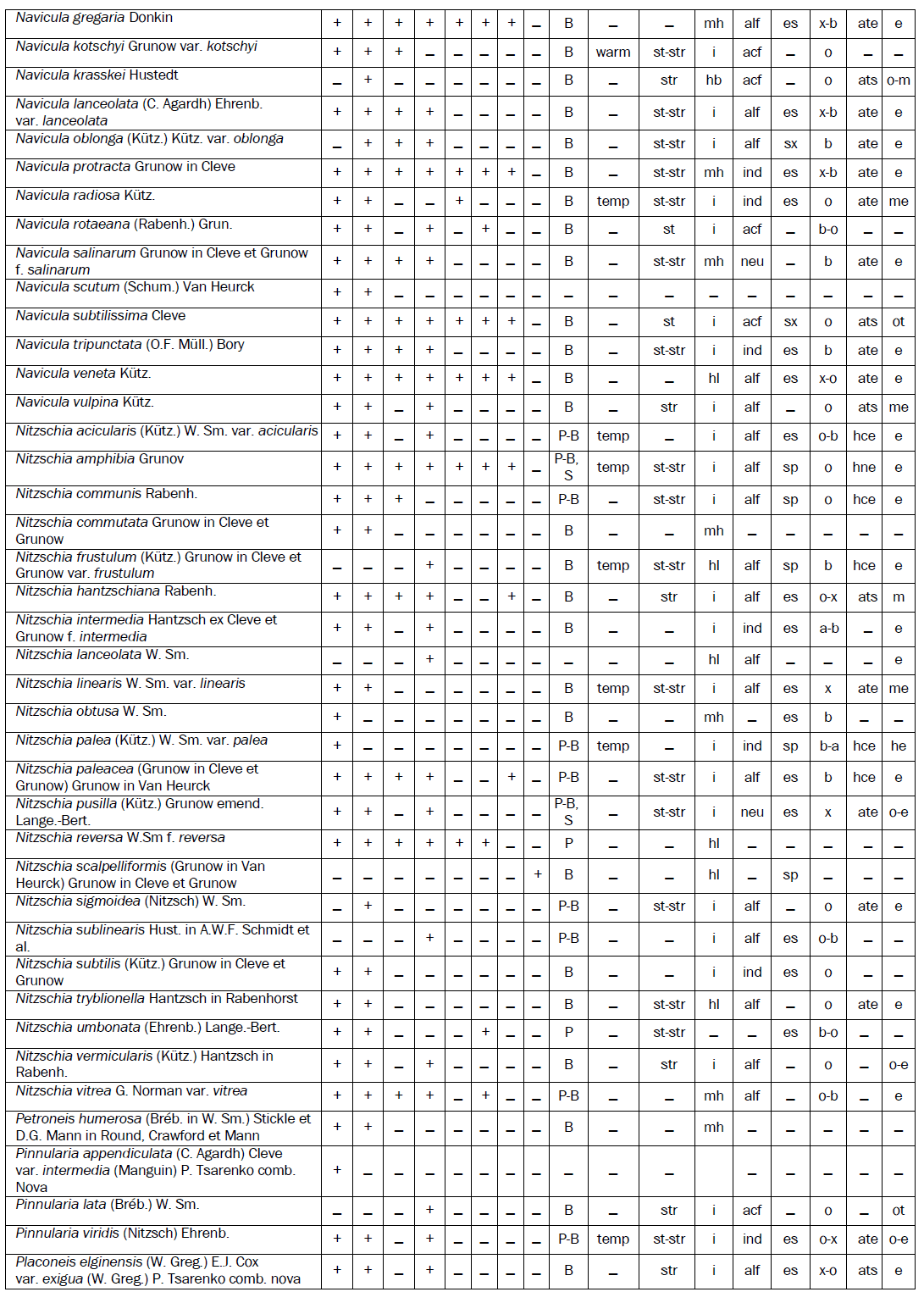
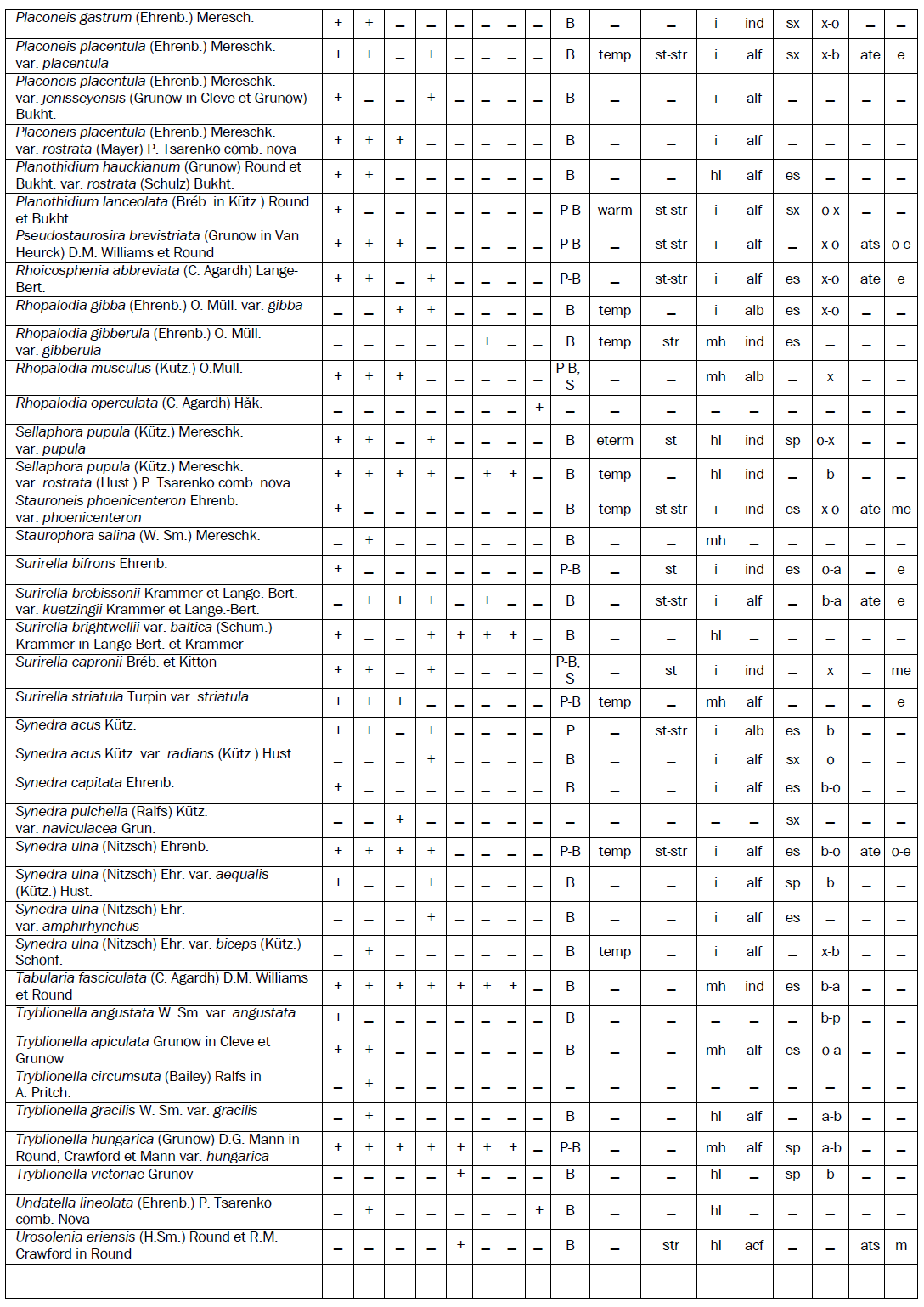
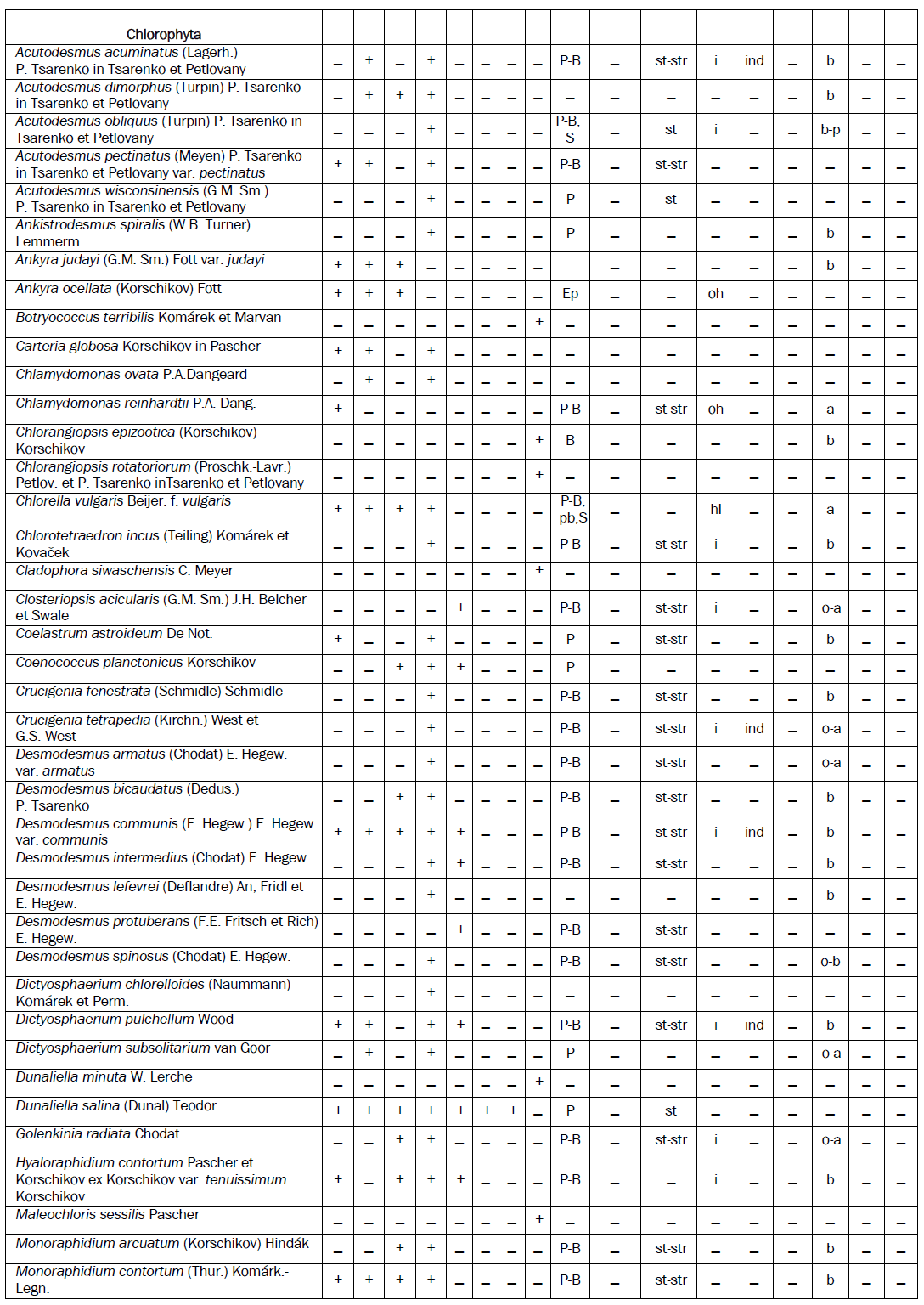
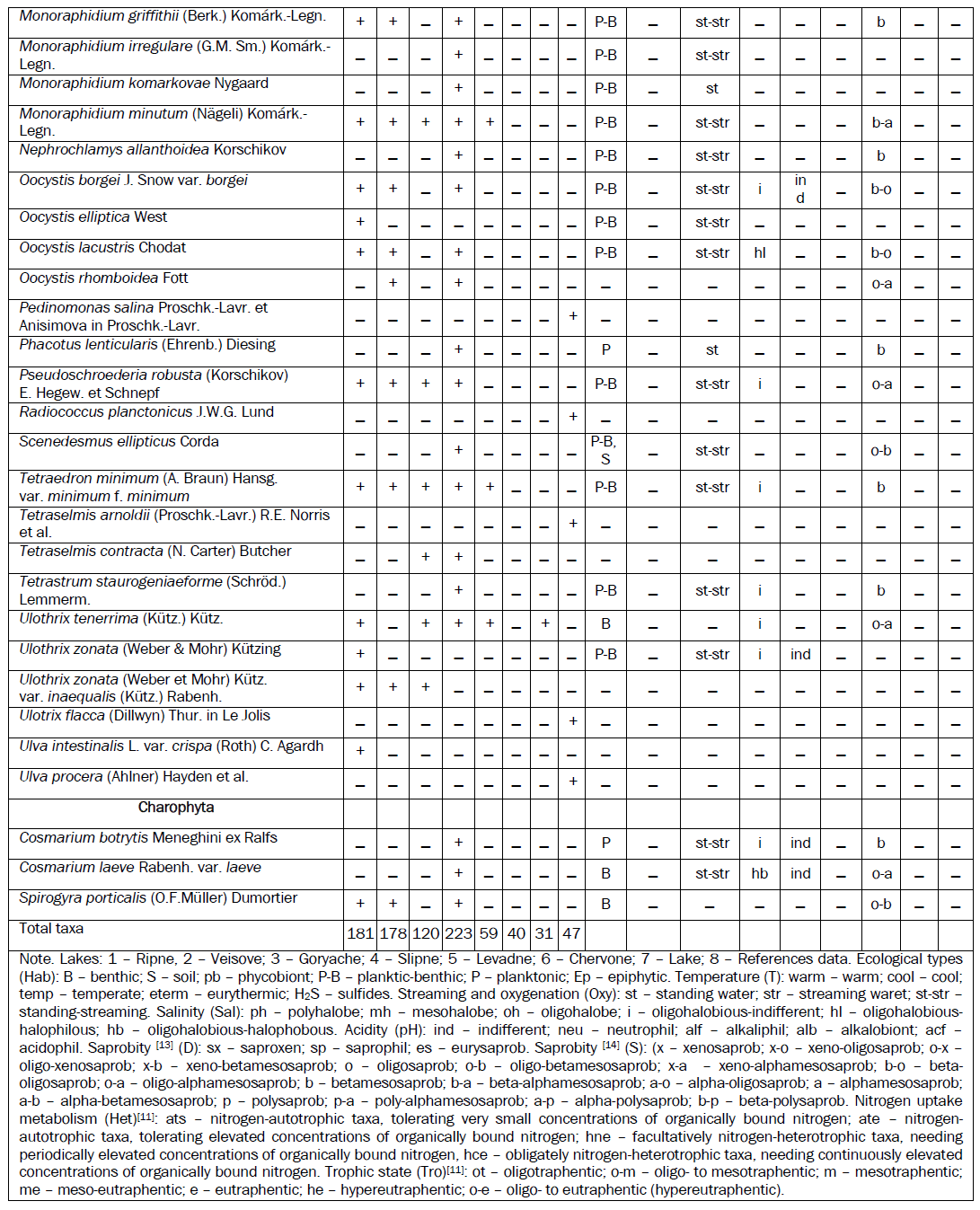
The plankton communities were dominated by Bacillariophyta species (49.43%), Cyanoprocaryota (18.47%) and Chlorophyta (17.9%), which constitute a significant majority of the species list that was cut off by the standard deviation line (Fig. 2a). Namely, the importance of these three taxonomical Divisions for flora of the Ukraine is a feature [1, 2, 15], reflecting a common regional features of algal flora.
Ecological analysis showed that the identified species were confined mostly to benthos inhabitants; among the dominant groups were also plankton-benthic inhabitants (which were marked by the trend line), these groups both are cut off by the standard deviation line (Table 1, Figure 2b). Despite the fact that the samples were plankton, they are collected in shallow lakes subject to anthropogenic and wind mixing, which leads to the separation of periphyton and benthic forms, in contrast to deep water bodies, where the benthic species are rare in plankton [15].
Salinity indicators represent 228 species belonging to five ecological groups (Table 1, Figure 3a). Oligohalobes-indifferents dominated and cut off by standard deviation line, but the top of the trend line also indicates the importance of the group halophiles. The presence of salt-water preferred groups of indicator species (oligohalobes-halophiles, and even mesohalobes and polyhalobes) reflects the diversity of mineralization from lake to lake and throughout the seasons. Drying, as one of the main factors of increasing salinity in lakes [16, 17], leads to the change diversity of algae and therefore is one of the climatic factors involved of algal flora formation [18]. However, climate impacts on water bodies generally aligns habitat with a predominance of fresh waters.
The alkaliphilic and indifferent indicator groups are prevailing in the lakes communities among the pH indicators, at which point the standard deviation and trend lines (Table 1, Figure 3b). They amounted to more than 85% of the total number of indicators of acidification. Thus, we can to conclude that algal communities of the studied lakes are not indicated of air pollution that can lead to acidification. Moreover, anthropogenic impact leads to alkalization of water in the lakes, thereby countering the negative impacts of acidification.
The bio-indication analysis showed that in relation to water oxygen saturation and the water mass moving predominated species-indicators of slightly stirred and medium oxygen-rich waters (Table 1, Figure 3c). This result is consistent with the habitat – shallow lakes with wind stirring.
Among indicators of temperature, the most significant was moderate temperature (temperate) group of indicators, that is cut off the standard deviation and trend lines (Table 1, Figure 3d). Bio-indication of water temperature is not yet developed enough [9], however, other estimates on this factor in the region [15] also show moderate temperature interval as regional climatic norm in fresh waters.
In determining the Water Quality Class the standard deviation line cut off only indicators groups II and III Class (Table 1, Figure 4a). Thus, bio-indication of organic pollution related mostly to anthropogenic impacts, shows that, despite the high recreational load, lake waters have quite satisfactory water quality.
The autotrophs are prevailing among indicators of nutrition type and relative to the amount of nitrogen-containing organic compounds. They develop at low concentrations of nitrogen-containing organic compounds and/or withstand the increase in the concentration of nitrogen-containing organic compounds, and cut off by standard deviation line (Table 1, Figure 4b). They are representing about 90 percent of the total number of indicators of nutrition. This shows that anthropogenic load takes place, but have not significant values of toxic substances, so the algae have the opportunity to nutrition direct through photosynthesis but not by heterotrophic way.
We assessed the trophic level of the lakes as well as the intensity of anthropogenic impact on ecosystems of studied lakes by bioindication methods. As a result of evaluation the trophic status was identified seven groups of indicators. Stood out the group most eutrophic species, that cut off by standard deviation line (Table 1, Figure 4c) as well as indicated by the top of the trend line. Thus, the relatively high trophic level – eutrophic, confirmed indication of the Water Quality Class as well as algal species type of nutrition, and leads to the conclusion about non-toxic anthropogenic pollution of the studied lakes.
We found significance of clear and middle-polluted water indicators that are cut off by standard deviation line (Table 1, Figure 4d) in determining the level of organic pollution according to Watanabe [13]. Saprophiles accounted for only about 13% of the total number of indicators of organic pollution. That led us to conclude that water in studied lakes is clean enough or moderately polluted.
In order to identify groups of lakes, similar in algal population diversity, similarity dendrogram was constructed by the Ward method based on Sorensen-Czekanowski indices (Figure 5). It is evident that at over 40% similarity the algal flora of the lakes are divided into two major clusters. The first includes communities of the lakes Ripne, Veysove, Garache, Slipne, relating to the northern part of the Park. The second combines communities of the Levadne, Chervone and Lake in south part of the park.
The natural history of the algal flora formation in the studied lakes leaves its mark on their floristic composition. The algal communities of the lakes, even those close to each other located, have their own characteristics, the so-called floristic face. Species composition of algae formed under the influence of nutrition source, morphometry, the chemistry and history of the use of each of the lakes. In order to reveal the historical connection of all lakes floras in the Park was built dendrite, which show measure of overlapping of the lists of the floras lakes. In Figure 6 seen that the percentage of the floras intersection is sufficiently high. However, the communities of algae in studied lakes can be divided into two floristic cores separated in the figure by the dashed line. The thickness of connection lines is proportional to the similarity of the floras. It is seen that the first core basically has the Chervone Lake flora (southern lakes group), and the second – the Veysove Lake (northern group of lakes). Location the lakes on the map of the Landscape Park shows that the first group included lakes Chervone, Levadne and Lake – small, partially drying up during the year, located in relative proximity to each other with floristic center in the lake Chervone. The second group represents the lakes Veysove, Garache, Ripne and Slipne – deeper, perennial, and is also closely located to each other with the floristic center in the lake Veysove. In the first group of lakes due to partial drying during the year there is a significant fluctuation of salinity, which is reflected in the species composition.
In general, lakes differ significantly in mineralization. Thus, the average conductivity of water in the lakes of the northern group was as follows: Ripne – 9.5 ± 1.6 mSm/cm, Veysove – 10.8 ± 0.2 mSm/cm, Garache – 9.3 ± 2.1 mSm/cm, Slipne – 6.6 ± 1.1 mSm/cm; in the lakes of the southern group: Levadne – 8.0 ± 3.1 mSm/cm, Chervone – 6.7 ± 3.6 mSm/cm, Lake – 11.0 ± 0.2 mSm/cm. In the part of the waters prevail sulfides, sulfates and chlorides, which affect the lakes mud, which in its composition classified as the type of sludge, middle mineralized sulfide, sulfate-chloride, sodium-lake muds according to the classification of the Central Research Institute of Balneology and Physiotherapy [19].
When comparing Slaviansk lakes and lakes in Kazakhstan with similar water conductivity was observed regular decrease in the number of species in the flora of lakes with increasing conductivity (Figure 7) [17]. So, in our lakes, for the period February–June 2013 in most low-mineralized lake Slipne was determined 75 algal taxa, whereas in the most saline lake – the Lake in the same period – only 31 taxa.
As a result, the number of freshwater species was higher as a whole, therefore, they contribute greatly to number of indicator species and trend of increasing the contribution of indicator groups show of mostly freshwater at the general characteristics of studied lakes. In this regard, for the Slavyansk Park lakes and lakes in Kazakhstan there is a similar distribution of the dominant groups of indicator species with oligohalobes-indifferents as the dominant group and fairly represented oligohalobes-halophiles and mesohalobes [17]. Therefore, in the florogenetic process two floristic cores of the lakes revealed the historical role of the chemistry of water in the lakes, which in turn is a function of periodic drying [16, 17, 18
The phytoplankton communities of studied lakes were dominated by algae from Bacillariophyta Cyanoprocaryota, and Chlorophyta taxonomic Divisions, reflecting a common regional feature of algal flora. In general, flora of the lakes can be assessed as a rich, consisting of 334 species of algae (352 species and infraspecific taxa) from nine Divisions, the majority of which (238 species and infraspecies) is the contribution of our study during 2007-2013.
Ecological analysis showed that most of algae are benthic and plankton-benthic, despite the fact that we select only the plankton. This is probably due to the separation of periphytonic forms in the shallow lakes as a result of anthropogenic and wind water mixing.
The bioindication methods that were first time implemented showed that the water of the lakes is slightly alkaline, medium enriched with oxygen and moderate range of temperature.
Assess the impact on the flora salty water was important because this salts composition is used for spa. It turned out that in salinity indicators are dominated oligohalobes-indifferents, and also important group was oligohalobes-halophiles, which prevails over a variety of salt-preferring species, dominant only in lakes Chervone and Lake.
Bio-indication organic pollution shows that, despite the high recreational load, water quality in the lakes is quite satisfactory, II and III Classes; the water is clean enough or moderately polluted. Algal species in studied lakes used of photosynthesis, whereas mixotrophes number was insignificant, that reflects the natural, non-toxic environment, despite the significant anthropogenic load.
The lakes have sufficiently high trophic level – eutrophic, confirmed by bioindication of organic pollution, Class of Water Quality, and photosynthetic type of algal nutrition
Since flora of studied lakes formed over a long historical period, we evaluated diversity floras in the lakes, by statistically calculating the similarity measure and the intersection of their species composition. It turned out that the similarity of the floras of the northern group of lakes (perennial lakes Ripne, Veysove, Garache, and Slipne) and southern group of lakes (partially/periodically drying lakes Levadne, Chervone, and Lake) allows us to consider the flora of the lake Veysove as a center of core of floristic composition of the northern group of perennial lakes and flora of the lake Chervone as a center of southern group. It should be noted that aridity factor influenced to the lakes water chemistry, which led to salinization and depletion of species composition on the one hand, and the other reflected on the process of floristic genesis, dividing the lakes in present time into two divergent groups.
Our study not only revealed a high diversity of algae in the lakes system of the Park, but also for the first time implemented bioindication and comparative floristic approaches show the importance of natural processes of aridity affecting the lakes water chemistry and the floristic composition of algae. Despite the high recreational load bioindication data show sufficient stability of lake ecosystems at present stage, which is necessary to study and protect its flora with further monitoring the water quality.
We are thankful to the Israeli Ministry of Absorption that partly funded this research.